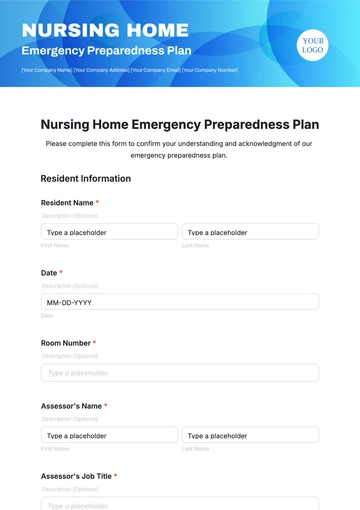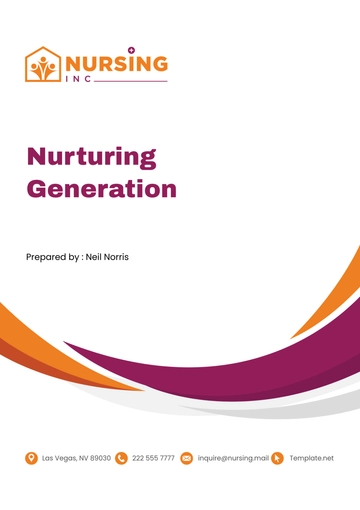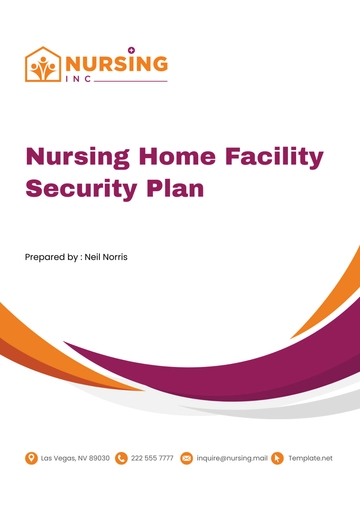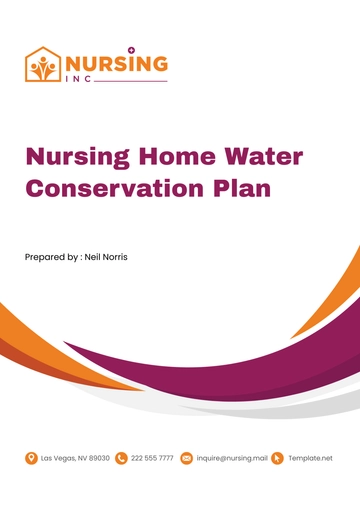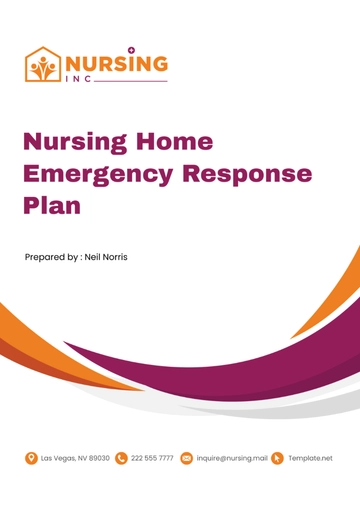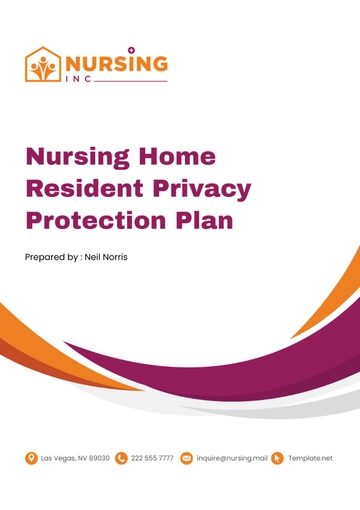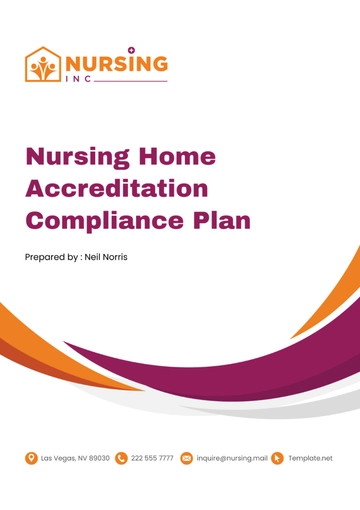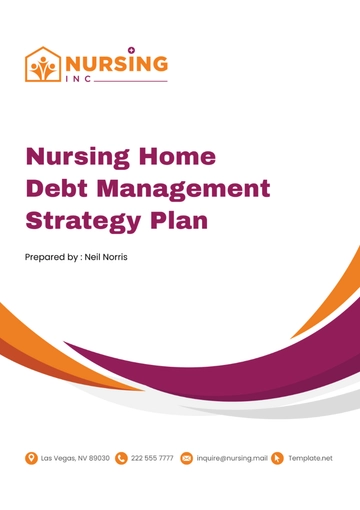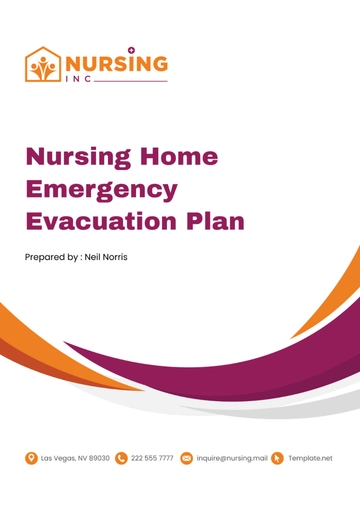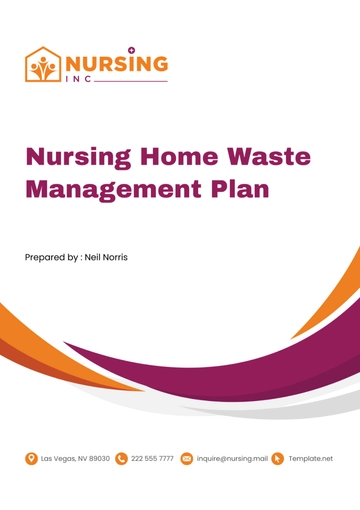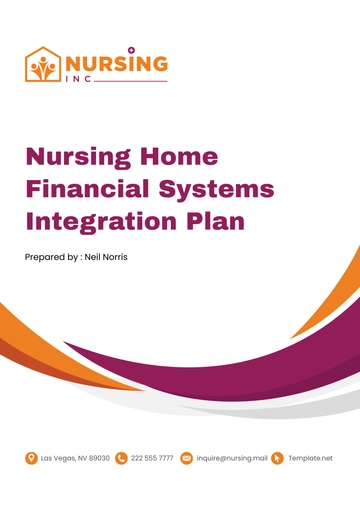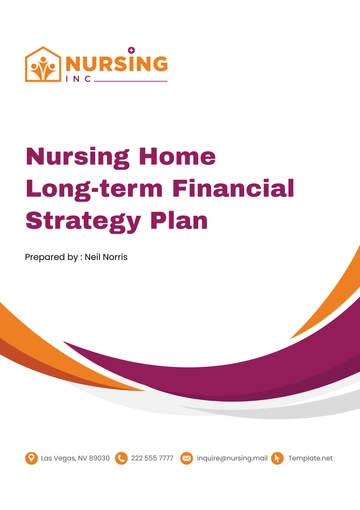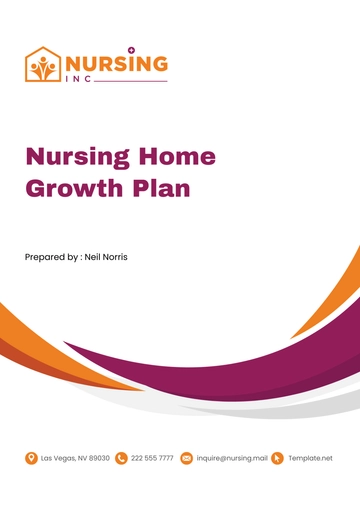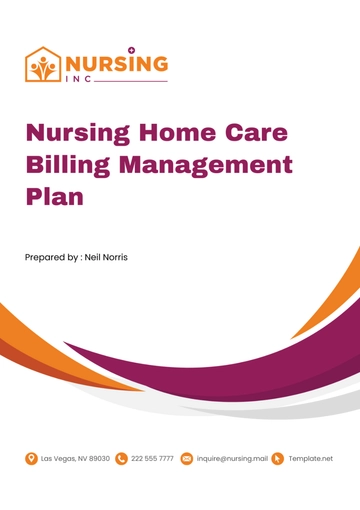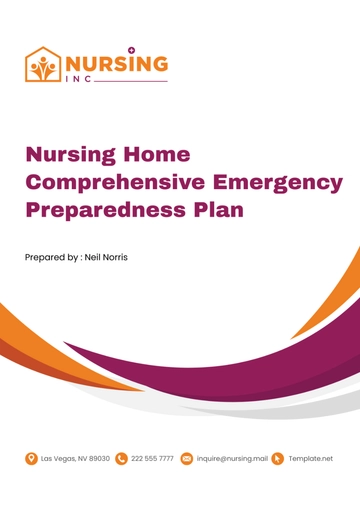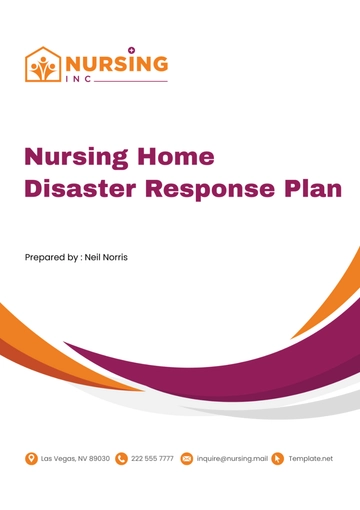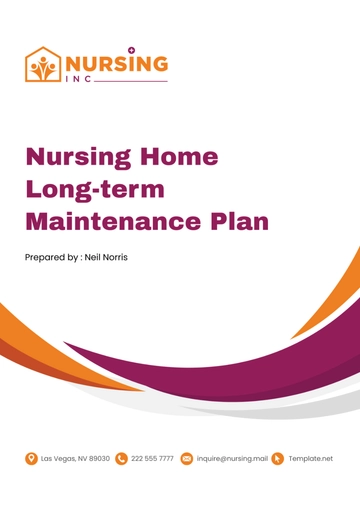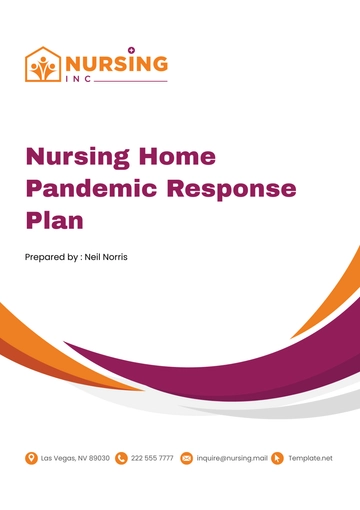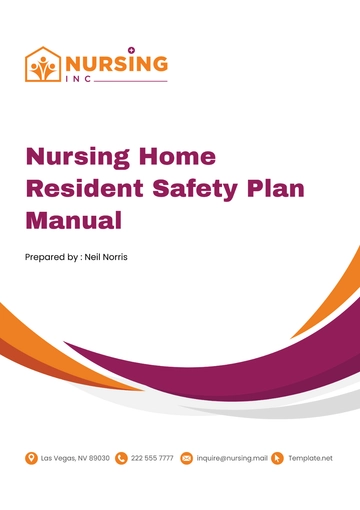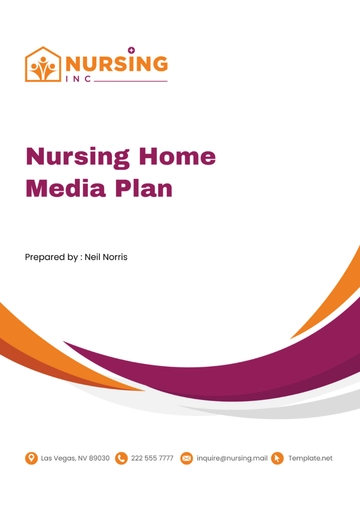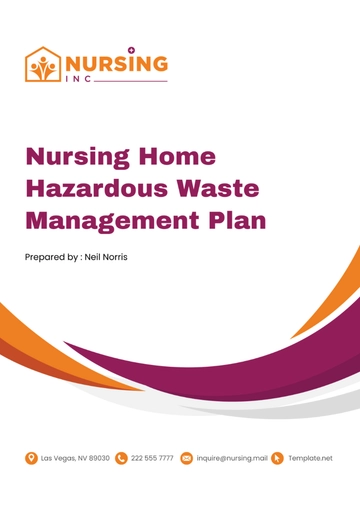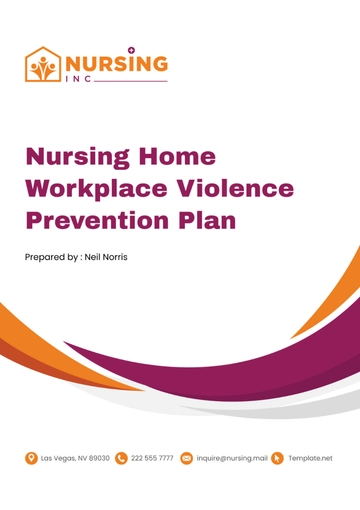Free Nursing Home Workplace Violence Prevention Plan

Introduction
[Your Company Name] is committed to creating and maintaining a safe, secure, and violence-free work environment for all its employees, residents, and visitors. This Workplace Violence Prevention Plan is designed to identify risks, implement preventative measures, and provide clear guidelines for responding to incidents of workplace violence. Our primary goal is to ensure the safety and well-being of everyone in our facility.
Risk Assessment
The first step in preventing workplace violence is to assess and identify potential hazards that could lead to violent incidents. This section outlines the findings of our risk assessment process, including identified risks and the measures in place to mitigate them.
Risk Factor | Level of Risk | Preventative Measures |
|---|---|---|
Interaction with potentially violent patients | High | Training in de-escalation techniques, secure work areas |
Late-night staffing | Medium | Enhanced lighting, security patrols |
Access control vulnerabilities | Medium | Installation of secure entry systems, visitor screening |
Communication with the Law Enforcement
Effective communication and strategic coordination with law enforcement agencies are critical to the robustness of our workplace violence prevention and response strategies. We prioritize establishing strong, proactive relationships with local police, emergency services, and other relevant authorities to enhance the safety and security of our facility.
Strategic Partnerships: We have formalized partnerships with local law enforcement and emergency services, which include regular coordination meetings to discuss security planning, threat assessment, and response strategies. These partnerships ensure that both our staff and the local authorities are familiar with our facility's layout, population, and specific needs.
Joint Training Exercises: To enhance the effectiveness of our coordinated response to violence or other emergencies, we conduct joint training exercises with local law enforcement. These exercises simulate various scenarios, including active shooter events, ensuring that both our staff and responding officers are prepared to work together seamlessly under stressful conditions.
Real-time Information Sharing: We utilize a secure communication platform for real-time information sharing with law enforcement. This system allows us to quickly relay critical information about ongoing incidents, enhancing the response time and situational awareness of responding units.
Community Policing Initiatives: Our facility participates in community policing initiatives, fostering an environment of mutual respect and collaboration. By engaging in these programs, we contribute to a broader community effort to prevent violence and ensure public safety.
Law Enforcement Liaison: We designate a member of our staff to serve as a law enforcement liaison. This individual is responsible for maintaining communication with local authorities, coordinating security efforts, and ensuring that any concerns or incidents are promptly addressed.
Physical Security Measures
Ensuring the physical security of our premises is paramount in safeguarding our residents, staff, and visitors against potential acts of violence. We employ a suite of security measures, designed not only to deter potential threats but also to provide a rapid and coordinated response in the event of an incident. Our approach is multifaceted, addressing the need for both technological solutions and human vigilance.
Advanced Surveillance System: We have deployed state-of-the-art surveillance cameras equipped with motion detection and night vision capabilities throughout the facility. This network is monitored 24/7 by security personnel, allowing for real-time detection and response to suspicious activities.
Access Control and Visitor Management: Our facility employs a sophisticated access control system, requiring keycard access for all employees. Visitors are rigorously screened upon entry, required to sign in, and provided with temporary identification badges, ensuring we have a record of everyone in the building at any given time.
Physical Barriers and Secure Perimeters: Perimeter fencing, well-lit walkways, and strategically placed barriers serve to prevent unauthorized access and ensure the safety of outdoor areas. These measures are designed to create a secure environment both inside and outside our buildings.
Emergency Preparedness and Evacuation Planning: We conduct regular emergency drills, including lockdown and evacuation procedures, to ensure that both staff and residents are prepared to respond effectively in a crisis. These drills are complemented by comprehensive emergency plans, tailored to a variety of potential scenarios.
Collaboration with Security Experts: Our security protocols are developed in collaboration with external security consultants, ensuring that our approaches are based on the latest industry standards and best practices. This partnership allows us to continuously evolve our security measures in response to new threats.
Support and Recovery
We recognize that the aftermath of workplace violence can have profound psychological and emotional impacts on victims, witnesses, and even the broader facility community. Our Support and Recovery program is designed to address these impacts comprehensively, offering a spectrum of services to support healing and resilience among our staff and residents.
Psychological Support: We provide immediate access to counseling services for all affected individuals, offering both individual and group therapy sessions facilitated by licensed mental health professionals. Our support services are designed to be flexible, accommodating the diverse needs and preferences of our staff and residents.
Employee Assistance Program (EAP): Our EAP offers a range of services, including mental health support, legal assistance, and financial counseling, to help employees navigate the challenges that can arise in the aftermath of violence. This program is confidential, ensuring employees can seek help without concern for stigma.
Reintegration Support: For those directly impacted by violence, returning to work or their normal routines can be daunting. We provide tailored reintegration plans, which may include phased returns, modified duties, and flexible scheduling options, to ease this transition.
Ongoing Education and Awareness: We host regular workshops and seminars on topics such as stress management, resilience building, and healthy coping strategies. These educational opportunities are open to all employees and residents, aimed at fostering a supportive community culture.
Continuous Improvement Through Feedback: Recognizing the importance of adaptability and continuous improvement, we actively seek feedback from those who have utilized our support services. This feedback is invaluable in helping us refine and enhance our support and recovery offerings.
Training Programs
Training is a critical component of our violence prevention strategy. It equips our staff with the knowledge and skills necessary to recognize, avoid, or de-escalate potential violent situations. Below is an overview of our training programs related to workplace violence prevention.
Training Program | Frequency | Target Participants |
|---|---|---|
De-escalation Techniques | Annually | All staff |
Workplace Violence Policy Overview | Biannually | New hires and all staff |
Emergency Response Procedures | Annually | All staff |
Facility Design and Environmental Safety
The design and physical layout of our facility play a crucial role in mitigating the risks associated with workplace violence. We incorporate safety and security considerations into the architectural design and environmental features of our premises, creating an environment that promotes well-being while deterring potential threats.
Natural Surveillance: The facility is designed to maximize visibility and natural surveillance. Strategic placement of windows, lighting, and landscape design allows for clear sightlines throughout the premises, enabling staff and security personnel to monitor activities effectively.
Controlled Entry Points: Entry to the facility is controlled through a limited number of access points, each equipped with security measures such as electronic locks and video surveillance. This allows for efficient monitoring and control of all individuals entering or leaving the premises.
Safe Havens: Certain areas within the facility are designated as safe havens, reinforced to offer protection in the event of an emergency. These areas are equipped with communication devices and emergency supplies, providing a secure space for residents and staff until help arrives.
Environmental Design for De-escalation: The facility's environment is designed to promote calm and reduce stress, incorporating elements such as natural light, open spaces, and calming colors. Such design choices are known to have a positive impact on behavior and can contribute to de-escalating potentially volatile situations.
Community Engagement and Awareness
Building a culture of safety and violence prevention extends beyond the boundaries of our facility. At [Your Company Name], we are committed to engaging with our local community to raise awareness about workplace violence, share resources, and foster a collective approach to prevention.
Public Awareness Campaigns: We participate in and often lead public awareness campaigns aimed at educating the community about the signs of potential violence, the importance of early intervention, and available resources for assistance.
Community Support Services: In collaboration with local organizations, we provide support services and educational programs that address factors contributing to violence, such as mental health issues and domestic conflict. These programs are designed to offer help before situations escalate to violence.
Volunteer Programs: Through volunteer programs, members of the community are invited to participate in activities within our nursing home, fostering strong bonds and a mutual understanding between our residents, staff, and the broader community. These programs not only enrich the lives of our residents but also create a network of community members invested in maintaining a safe environment.
Incident Response and Reporting
Despite our best efforts to prevent violence, incidents may still occur. This section outlines our procedures for responding to and reporting workplace violence incidents, ensuring timely and appropriate actions are taken to address and mitigate any harm caused.
Step | Description |
|---|---|
Immediate Response | Ensure safety, provide aid, call emergency services if necessary |
Reporting to Supervisors | Incident report to be completed and submitted within 24 hours |
Investigation | Conducted by the Workplace Violence Prevention Team |
Follow-Up | Review findings, provide support, implement corrective actions |
Conclusion
[Your Company Name]'s Workplace Violence Prevention Plan is a comprehensive approach designed to safeguard our facility against the threat of workplace violence. We aim to maintain a safe and secure environment for all employees, residents, and visitors. Our commitment to the principles outlined in this plan is unwavering, and we will continue to review and update our policies as necessary to adapt to new challenges and ensure the safety of our community.
- 100% Customizable, free editor
- Access 1 Million+ Templates, photo’s & graphics
- Download or share as a template
- Click and replace photos, graphics, text, backgrounds
- Resize, crop, AI write & more
- Access advanced editor
Address workplace safety with the Nursing Home Workplace Violence Prevention Plan Template from Template.net. This editable, customizable template serves as a foundational tool in crafting a comprehensive violence prevention plan. Easily modified in our Ai Editor Tool, it's designed to help you create a safer, more secure workplace environment.
You may also like
- Finance Plan
- Construction Plan
- Sales Plan
- Development Plan
- Career Plan
- Budget Plan
- HR Plan
- Education Plan
- Transition Plan
- Work Plan
- Training Plan
- Communication Plan
- Operation Plan
- Health And Safety Plan
- Strategy Plan
- Professional Development Plan
- Advertising Plan
- Risk Management Plan
- Restaurant Plan
- School Plan
- Nursing Home Patient Care Plan
- Nursing Care Plan
- Plan Event
- Startup Plan
- Social Media Plan
- Staffing Plan
- Annual Plan
- Content Plan
- Payment Plan
- Implementation Plan
- Hotel Plan
- Workout Plan
- Accounting Plan
- Campaign Plan
- Essay Plan
- 30 60 90 Day Plan
- Research Plan
- Recruitment Plan
- 90 Day Plan
- Quarterly Plan
- Emergency Plan
- 5 Year Plan
- Gym Plan
- Personal Plan
- IT and Software Plan
- Treatment Plan
- Real Estate Plan
- Law Firm Plan
- Healthcare Plan
- Improvement Plan
- Media Plan
- 5 Year Business Plan
- Learning Plan
- Marketing Campaign Plan
- Travel Agency Plan
- Cleaning Services Plan
- Interior Design Plan
- Performance Plan
- PR Plan
- Birth Plan
- Life Plan
- SEO Plan
- Disaster Recovery Plan
- Continuity Plan
- Launch Plan
- Legal Plan
- Behavior Plan
- Performance Improvement Plan
- Salon Plan
- Security Plan
- Security Management Plan
- Employee Development Plan
- Quality Plan
- Service Improvement Plan
- Growth Plan
- Incident Response Plan
- Basketball Plan
- Emergency Action Plan
- Product Launch Plan
- Spa Plan
- Employee Training Plan
- Data Analysis Plan
- Employee Action Plan
- Territory Plan
- Audit Plan
- Classroom Plan
- Activity Plan
- Parenting Plan
- Care Plan
- Project Execution Plan
- Exercise Plan
- Internship Plan
- Software Development Plan
- Continuous Improvement Plan
- Leave Plan
- 90 Day Sales Plan
- Advertising Agency Plan
- Employee Transition Plan
- Smart Action Plan
- Workplace Safety Plan
- Behavior Change Plan
- Contingency Plan
- Continuity of Operations Plan
- Health Plan
- Quality Control Plan
- Self Plan
- Sports Development Plan
- Change Management Plan
- Ecommerce Plan
- Personal Financial Plan
- Process Improvement Plan
- 30-60-90 Day Sales Plan
- Crisis Management Plan
- Engagement Plan
- Execution Plan
- Pandemic Plan
- Quality Assurance Plan
- Service Continuity Plan
- Agile Project Plan
- Fundraising Plan
- Job Transition Plan
- Asset Maintenance Plan
- Maintenance Plan
- Software Test Plan
- Staff Training and Development Plan
- 3 Year Plan
- Brand Activation Plan
- Release Plan
- Resource Plan
- Risk Mitigation Plan
- Teacher Plan
- 30 60 90 Day Plan for New Manager
- Food Safety Plan
- Food Truck Plan
- Hiring Plan
- Quality Management Plan
- Wellness Plan
- Behavior Intervention Plan
- Bonus Plan
- Investment Plan
- Maternity Leave Plan
- Pandemic Response Plan
- Succession Planning
- Coaching Plan
- Configuration Management Plan
- Remote Work Plan
- Self Care Plan
- Teaching Plan
- 100-Day Plan
- HACCP Plan
- Student Plan
- Sustainability Plan
- 30 60 90 Day Plan for Interview
- Access Plan
- Site Specific Safety Plan
